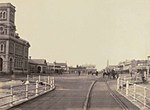Glenelg, South Australia
Gulf St VincentSeaside resorts in AustraliaSuburbs of AdelaideTourist attractions in AdelaideUse Australian English from August 2019

Glenelg is a beach-side suburb of the South Australian capital of Adelaide. Located on the shore of Holdfast Bay in Gulf St Vincent, it has become a tourist destination due to its beach and many attractions, home to several hotels and dozens of restaurants. Established in 1836, it is the oldest European settlement on mainland South Australia. It was named after Lord Glenelg, a member of British Cabinet and Secretary of State for War and the Colonies. Through Lord Glenelg the name derives from Glenelg, Highland, Scotland.
Excerpt from the Wikipedia article Glenelg, South Australia (License: CC BY-SA 3.0, Authors, Images).Glenelg, South Australia
Raymond Grove, Adelaide Glenelg
Geographical coordinates (GPS) Address Nearby Places Show on map
Geographical coordinates (GPS)
| Latitude | Longitude |
|---|---|
| N -34.982244 ° | E 138.513633 ° |
Address
Raymond Grove
Raymond Grove
5045 Adelaide, Glenelg
South Australia, Australia
Open on Google Maps





